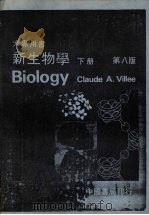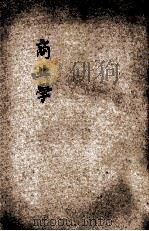《最新生物学 下》
| 作者 | 新陆书店编译 编者 |
|---|---|
| 出版 | 未查询到或未知 |
| 参考页数 | 578 |
| 出版时间 | 没有确切时间的资料 目录预览 |
| ISBN号 | 无 — 求助条款 |
| PDF编号 | 817403198(仅供预览,未存储实际文件) |
| 求助格式 | 扫描PDF(若分多册发行,每次仅能受理1册) |

目录1
第二十章 代谢作用和营养1
20-1 基底代谢率2
20-5 维生素(Vitamins) 12
20-2 燃料3
20-3 醣类、脂肪及蛋白质的代谢作用5
20-4 食物中其他的成份(Other Component of the Diet)10
20-6 脂溶性维生素14
20-7 水溶性维生素17
20-8 抗代谢物25
20-9 食物25
问题26
第二十一章 排泄作用(Chapter Excretion)30
21-1 肾脏及其管子(The Kidney and its duts)31
21-2 尿之形成31
21-3 肾的调节作用35
33-1 古生物学(化石学)36
21-4 尿中所含之物质(Substances Present in the Urine)37
21-5 肾脏病(Disea ses of the Kion eys)38
21-6 其他动物之排泄器构造(Excretory Devices in other animals)38
问题41
第二十二章 皮肤、骨骼以及肌肉保护作用以及行动作用42
22-1 皮肤(The Skin)42
22-2 骨骼(The Skin)45
22-3 行动之动类(Types of Locomotion)49
22-4 骨骼肌(Skelela Muscles)49
22-5 收缩的种类(Kinds of Contraction)52
22-6 肌肉收缩之生化学(The Biochemistry ofMu-scular contraction)56
22-8 低龄动物的肌肉(The Muscles Lower Animals)62
22-7 心脏肌与平滑肌(Cardiac and Smooth Muscle)62
问题65
第二十三章 控制系统:神经的统一性(Control Systems:Neural inte gration)66
23-1 神经原(Neurons)66
23-2 神经冲动(The Nerve Impulse)68
23-3 神经传导的膜状理论(TheMembrane The of Nerve Conduction)70
23-4 联会处的转移(Transmissin at the Synapse74
23-5 中枢神经系统脊髓(The Central Nervous syst-em:Spinal Cord)78
23-6 中枢神经系统(The Central Nervous system:the Brain)78
23-7 脑波(Brain Waves)84
23-8 睡眠(Sleep)84
23-9 神经错乱与神经病(Insanity and Neuroses)86
23-10 周围神经系统(The Peripheral Nervous sys-tem)87
23-11 反射及反射弧(Reflexs and Reflex Arcs)88
23-12 思想记忆与学习的过程(Thoughts,Memory and the Learning Process)91
23-13 自主神经系统(The Autonomic Nervous syst-em)93
23-14 低等动物的神经系统(The Nervous Systems of Lower Animals)94
问题98
第二十四章 特殊受纳器:感觉器官99
24-1 接受刺激的过程(The Stimulus-Receiving Process)100
24-2 感觉的理解作用(The Perception of sensati-ons)100
24-3 刺激的定位作用(The Localization of stimuli)101
24-4 触觉作用(Tactile senses)101
24-5 化学感觉:味觉和嗅觉(Chemical senses:tas-te and smell)104
24-6 视觉(Vision)105
24-7 人类的眼睛(The human Eye)107
24-8 视觉化学(The Chemistry of Vision)110
24-9 视觉缺陷(Defects in Vision)113
24-10 耳朵(The Ear)114
24-11 平衡(Equilibrium)120
问题122
第二十五章 控制系统:激素的统一性123
25-1 内分泌腺(Endocrine Glands)123
25-2 甲状腺(The Thyroid Glands)127
25-3 副甲状腺(The Parathyroid Glands)132
25-4 胰脏的小岛细胞(The Islet Cells of the Pancreas)133
25-5 肾上腺(The Adrenal Glands)136
25-6 脑下垂体(The Pituitary)138
25-7 睾丸(The Testes)143
25-8 卵巢145
25-9 动情周期及月经周期146
25-10 胎盘148
25-11 其他分泌腺体149
25-12 内分泌腺之间相互关系149
25-13 外分泌素150
问题152
第二十六章 传染病、免疫及过敏154
26-1 微生物如何引起疾病154
26-2 身体对于疾病的防御力155
26-3 免疫反应156
26-4 免疫性耐性161
26-5 过敏性162
26-6 抗生素164
26-7 微生物之散播165
26-8 一些普通传染病166
问题172
第二十七章 生殖173
27-1 无性生殖173
27-2 动物之有性生殖174
27-3 人类的生殖作用178
27-4 胚胎膜(The Embryonic Membranes)185
27-6 出生(Birth)187
27-5 胎盘(The Placents)187
27-7 婴儿的管养(Nutrition of the Infant)189
问题190
第二十八章 胚胎的发育191
28-1 卵的种类(Types of Eggs)191
28-2 卵裂及原肠形式(Cleavage andGastrulation)192
28-3 中胚层的形成(Mesoderm Formation)198
28-4 神经系统的发育(Development of the Nervous System)202
28-5 体形的发育(Development of body form)202
28-6 心脏的形成(Formation of the hea rt)206
28-7 消化管的发育(Development of the Digestive Tract)208
28-8 肾脏的发育(The Development of Kidney)209
28-9 发育过程的调节(What Regulates Developme-ntal Processes)210
28-10 畸形(Malformations)216
28-11 双胞胎(Twinning)217
28-12 出生时的改变(Changes at Birth)218
问题220
二十九章 传递遗传学:遗传的染色体理论221
29-1 遗传学的发展(The Development of Genetics)221
29-2 染色体与基因(Ghromosomes and Genes)223
29-3 有丝分裂(Mitosis)225
29-4 减数分裂(Meiosis)232
29-5 睾丸的发生(Spermatogenesis)234
29-6 卵的发生(Oogenesis)239
29-7 基因与偶对性质(Genes and Alleles)242
29-8 单性杂交(A Monohybr id cross)243
29-9 表型和性型(Phenotype and Genotype)244
29-10 或然率之比(Incomplete Dominance)245
29-11 不完全显性(Deducing Genotypes)247
29-12 性型的推论(Deducing Genotypes)248
29-13 孟德尔定律(Mendel's Laws)250
29-14 基因的相互作用(Genic Interactions)252
29-15 多基因遗传(Polygenic Inheritance)253
29-16 复数偶对性质(Multiple Alleles)256
29-17 联结与互换(Linkage and Crossing over)257
29-18 性别的遗传决定(The Genetic Determination of sex)261
29-19 性联遗传及性别影响特征(Sex-Linked and Sex-Influenced Traits)263
29-20 近亲交配与非亲交配(Inbreeding and Outbre-eding)265
问题267
第三十章 基因的构造和功能270
30-1 染色体的分子构造(The Molecular Stru-cture of Chromosomes)271
30-2 遗传信息是被DNA所传建的(Genetic Inform-ation is Transmitted by DNA)272
30-3 DNA之化学组成(The Chernical Composition of DNA)276
30-4 华特生和克莱克的D NA模型(The Watson-Cr-ick Model of DNA)277
30-5 基因是什么?(What is Gene?)281
30-6 遗传密码(The Genetic Code)283
30-7 DNA的合成:复制(The Synthesis of DNA:Replication)287
30-8 密码的抄写:信息RNA的合成(Transcription of the Code:The Svnthesis of Messenger RNA)289
30-9 RNA的类型:信息核醣和转移(Types of RNA:Messenger,Ribosomal and Transfer)291
30-10 一种特殊多缩氨酸链之合成(The Synthesis of A Specific Polypeptide Chain)293
30-11 基因与酵素之关系(Gene-EnzymeRelations)296
30-12 基因与分化(Genes and Differentiation)300
30-13 作用因子的观念:蛋白质合成之控制(The………Operon Concept:Control of Protein Synthe-sis)304
30-14 基因的变化:突变(Changes in Genes Mutations)307
30-15 致死基因(Lethal Genes)310
30-16 基因表型比率及基因表现(Penet rance and Exp-ressivity)312
问题313
第三十一章 人的遗传315
31-1 机率定律(The Laws of Probability)315
31-2 族群遗传学(Population on Genetics)317
31-3 人类细胞遗传学(Human Cytogentics)322
31-4 身体特性的遗传(The Ipheritance of Physical Traits)324
31-5 矫力的遗传(The Inheritance of Mental Abi-325
lities)325
31-6 遗传与环境:双胞胎的研究(Heredity and Env-ironment:Twin Studies)330
31-7 优生学(Eugenics)333
问题335
第六部份之介绍337
32-1 演化观念的历史发展(Histor ical Development of the Concept of evolution)338
第三十二章 演化的原理与理论338
32-2 达尔文与华莱士的天择说(The Darwin-Wallace Theory of Natural Selection)340
32-3 族群与基因池(Population and Gene Pools)342
32-4 分化的生殖(Differential Reproduction)344
32-5 突变(Mutations)346
32-6 平衡的多形性(Balanced Polymorphism)350
32-7 适应的辐射作用(Adaptive Radiation)350
32-8 渐进演化(Speciation)351
32-9 杂交与种之起源(The Origin of Species by Hybridzation)354
32-10 直线演进(Straight-Line Evolution)356
32-11 生命之起源(The Origin of Life)357
32-12 进化之原理(principles of Evolution)360
问题362
第三十三章 进化之化石证据363
33-2 地质年代表(The Geologic Time Table)365
33-3 前寒世纪的生物(Precambrianlife)366
33-4 古生物年代(The Paleozoic Era)370
33-5 中古生物时代(The Mesozoic Era)375
33-6 新生代(The Cenozic Era)385
问题391
第三十四章 演化的证据392
34-1 分类学上的证据(Evidence from Taxonomy)392
34-2 形态学上的证据(Evidence from Morphology)393
34-3 比较生理学上和生物化学上的证据(Evidence from Comparative Physiology and Biochem-istry)394
34-4 比较胚胎学上的证据(Evidence from Compar-ative Embryology)396
34-5 遗传学上的证据(Evidence from Genitics)398
34-6 生物地理学的证据(Evidence from Biogeogr-aphy)399
34-7 生物的地理分布范围(The Biogeographic Real-ms)401
问题403
第三十五章 人类的演化404
35-1 灵长目(The Primates)404
35-2 灵长目的化石(Fossil Primates)411
35-3 人猿(The Manape)413
35-4 猿人化石(Fossil Apemen)415
35-5 人属内的化石(Foss il Members of the Genus Homo)417
35-6 人类与其化石Fossil and Living Homo Sapi-ens)420
35-7 文化上的进化(Cultural Evolution)423
35-8 现代人类的种族(The present Races of Man)425
问题433
第三十六章 生态学的规则435
36-1 动物和植物的范围与界限(The Ranges and Li-mits of Plants and Animals)435
36-2 食物链与金字塔(Food Chains and Pyramids)437
36-3 人口和他们的性格(Populations and their Characters)439
36-4 人口的周期(Population Cycles)443
36-5 生物学上的周期现象:循环频率(Cyclic Pheno-mena in Biology:Circadian Rhythms)446
36-6 生物分布和范围(Population Dispers ion and Territoriality)449
36-7 生物的社会(Biotic Communities)450
36-8 社会系列(Community Succession)450
36-9 保存(Conservation)453
问题455
第三十七章 适应与环境(Adaptations and Ecosystems)456
37-1 构造上的适应(Structural Adaptations)456
37-2 生理的适应(Physiologic Adaptations)457
37-3 颜色的适应(Color Adaptations)458
37-4 种类间的适应(Adaptation of Specis to Spe-cies)460
Biomes)461
37-5 地球生物分布区域(Terrestrial Life Zones:461
37-6 冻土地带的生物(The Tundra Biome)464
37-7 森林族群(The Forest Bioms)466
37-8 草原地区(The Grassl and Biome)468
37-9 矮丛林地带(The Chaparral Biome)470
37-10 荒漠地带(The Desert Biome)471
37-11 海洋的边界:沼泽和江湾(The Edge of the Sea:Marshes and Estuaries)473
37-12 海产生物地带(Marine Life Zones)474
37-13 淡水生物区域(Fresh Water Life Zones)478
37-14 自然界的动的平衡(The Dynamic Balance of Nature)478
问题480
附录481
植物与动物做分类481
《最新生物学 下》由于是年代较久的资料都绝版了,几乎不可能购买到实物。如果大家为了学习确实需要,可向博主求助其电子版PDF文件。对合法合规的求助,我会当即受理并将下载地址发送给你。
高度相关资料
-

- 科学图书大库 最新生物学 下 生命的探讨
- 1979 徐氏基金会
-

- 最新植物化学
- 1978
-

- 最新微生物学
- 昭和38年01月 株式会社广川书店
-

- 最新生薬化学
- 广川书店
-

- 最新微生物学
- 1977
-

- 新生物学 下
- 之宜出版社
-

- 生物学 下
- 1980.04 北京市:高等教育出版社
-

- 最新植物化学
- 1964 徐氏基金会
-

- 最新药理药物学
- 1951 文林书店
提示:百度云已更名为百度网盘(百度盘),天翼云盘、微盘下载地址……暂未提供。➥ PDF文字可复制化或转WORD





